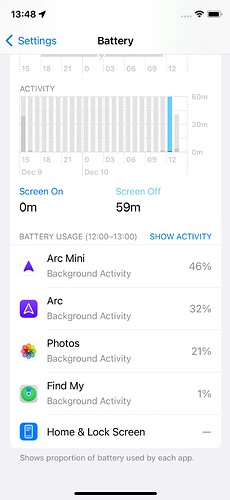Hi @denleschae!
First thing to clarify is that those screenshots aren’t telling you what you’re thinking they’re telling you. The Settings → Battery view includes energy used while plugged in to power, and because Arc runs everything on device, with no server side component, there are significant background tasks for housekeeping that run when plugged in to power. Those throw off the Settings → Battery view results significantly on most days.
Also when the Settings → Battery view says things like “Background location” that doesn’t actually mean that’s what used the most energy, it’s just saying that because the app did do that thing. In practice those secondary sentences don’t equate to what actually caused the majority of the energy drain. It’s useful information sometimes, but more often than not it’s misleading, because it implies something that usually isn’t the case.
This it the actual test you want to pay attention to! The Settings → Battery view will mislead you more often than not, and can’t tell you what’s really going on, but if you’re having the phone run out of charge earlier in the day and requiring earlier charging, then that’s real world data that indicates a problem.
Although keep in mind that it could also merely indicate that you used more screen time than you usually would. Screen time is what eats battery, with almost everything else being insignificant in comparison.
As I’ve shown further up in the thread, Arc’s timeline recording can run continuously for 24-48 hours on a single charge, even on older model phones with dying batteries. It’s not the recording that eats battery - that is extremely efficient (and sometimes even more efficient than other apps that record significantly less detail and data).
The overwhelming majority of Arc’s energy consumption comes from screen time, updating the UI and the map, and paying the cost of powering the screen (which is attributed to whichever app is in the foreground at the time).
So the thing to look for is how much time Arc was “on screen” (shown when you tap the “SHOW ACTIVITY” button in the Settings → Battery view).
Because Arc’s UI is more complex than most other apps of this kind, and it shuffles around much more data than all other apps of this kind, that screen time is more expensive than most. (Aside: That is something I’m working to improve in upcoming releases, with modernisation of the UI code, and UI energy efficiency improvements where I can find them).
Anyway, what I would suggest is to:
- Pay attention to the amount of screen time Arc is accumulating versus other apps
- Give it at least 10 days, and have a look at the “Last 10 Days” view of Settings → Battery, again paying attention to relative screen time
Although that 10 day view will still mislead you, due to it including the energy consumed when the app is doing its daily scheduled housekeeping tasks while plugged in to power. But it can still give you a better sense of what’s going on, to a degree.
For example the 10 day view on my main phone shows:
| App |
Energy |
Screen time |
| Arc App |
11% |
19h 13m |
| Threads |
8% |
8h 22m |
So from that I can see that even though Arc used 3% more energy relative to Threads app over 10 days, it had more than twice as much screen time, so that’s actually a big win in terms of efficiency. Like, if they were both using the same amount of energy per minute of screen time, then Arc should’ve used twice as much energy, ie 16%.
Oh, and last point: Don’t forget that the percent shown in Settings → Battery isn’t the amount of energy it used of a single battery charge, it’s the amount of energy used relative to other apps during that time period. So if for example only 10% of a single battery charge was used, and only two identical apps were installed on the phone, each having exactly the same amount of time on screen, then each app would show as 50%, even though in reality what it means is each app used only 5% of a battery charge.
So it’s important to remember that the absolute values of those percentages don’t really tell you anything - it’s the relative values that matter. The comparison you want to make is one app’s percent versus the next app’s percent, and not to compare either of them to 100%, because the Settings → Battery view doesn’t tell you what 100% actually is in terms of a full battery charge.












